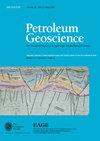A new approach to investigate the effect of burial depth and clay content on fault permeabilities applied at the Njord Field
IF 1.9
4区 地球科学
Q3 GEOSCIENCES, MULTIDISCIPLINARY
引用次数: 0
Abstract
Fault permeability prediction typically relies on empirical relationships between permeability and clay content or burial depth. Calibration of such methods relies on either core data or subsurface observations of fluid pressure and hydrocarbon contact offsets across faults. Published core data suggest that no relationships exist between host rock clay content and fault permeability for phyllosilicate-framework fault rocks, whereas published subsurface calibration data suggest otherwise. We here present a new method for calibration of fault rock permeabilities to subsurface pressure data. This approach is an analogue from electrical engineering to compute fault permeabilities across all major faults in a study area and optimise depth and clay content dependence of fault permeabilities. We tested this method at the Jurassic section of the Norwegian Njord Field area, where faults span the depth range of 2.7- 4.5 km and the lowest clay content in individual faults varies between 8.9 to 25.7%. The flow-restricting faults at Njord are phyllosilicate-framework fault rocks. Our modelling shows that fault rock permeability decreases with burial depth, whereas the clay content has nearly no impact. Sensitivity analyses show that these results are robust. Therefore, SGR-based algorithms for fault seal prediction cannot be expected to give good fault permeability predictions for seismic-scale faults at Njord. Thematic collection: This article is part of the Fault and top seals 2022 collection available at: https://www.lyellcollection.org/topic/collections/fault-and-top-seals-2022 Supplementary material: https://doi.org/10.6084/m9.figshare.c.6824325应用于Njord油田研究埋深和粘土含量对断层渗透率影响的新方法
断层渗透率预测通常依赖于渗透率与粘土含量或埋深之间的经验关系。这些方法的校准要么依赖于岩心数据,要么依赖于流体压力的地下观测,要么依赖于断层上的油气接触偏移。公开的岩心数据表明,层状硅酸盐-格架断层岩石的主岩粘土含量与断层渗透率之间不存在关系,而公开的地下校准数据则相反。本文提出了一种将断层岩石渗透率与地下压力数据进行校正的新方法。该方法是一种类似于电气工程的方法,用于计算研究区域内所有主要断层的断层渗透率,并优化断层渗透率对深度和粘土含量的依赖。我们在挪威Njord油田的侏罗纪剖面测试了这种方法,该地区的断层深度范围为2.7- 4.5 km,单个断层的最低粘土含量在8.9 - 25.7%之间。Njord的限流断层为层状硅酸盐-格架断裂岩。我们的模型表明,断层岩渗透率随埋深而降低,而粘土含量几乎没有影响。敏感性分析表明,这些结果是稳健的。因此,不能指望基于sgr的断层封闭性预测算法能很好地预测Njord地震级断层的断层渗透率。专题合集:本文是故障和顶部密封2022合集的一部分,可在:https://www.lyellcollection.org/topic/collections/fault-and-top-seals-2022补充材料:https://doi.org/10.6084/m9.figshare.c.6824325
本文章由计算机程序翻译,如有差异,请以英文原文为准。
求助全文
约1分钟内获得全文
求助全文
来源期刊

Petroleum Geoscience
地学-地球科学综合
CiteScore
4.80
自引率
11.80%
发文量
28
审稿时长
>12 weeks
期刊介绍:
Petroleum Geoscience is the international journal of geoenergy and applied earth science, and is co-owned by the Geological Society of London and the European Association of Geoscientists and Engineers (EAGE).
Petroleum Geoscience transcends disciplinary boundaries and publishes a balanced mix of articles covering exploration, exploitation, appraisal, development and enhancement of sub-surface hydrocarbon resources and carbon repositories. The integration of disciplines in an applied context, whether for fluid production, carbon storage or related geoenergy applications, is a particular strength of the journal. Articles on enhancing exploration efficiency, lowering technological and environmental risk, and improving hydrocarbon recovery communicate the latest developments in sub-surface geoscience to a wide readership.
Petroleum Geoscience provides a multidisciplinary forum for those engaged in the science and technology of the rock-related sub-surface disciplines. The journal reaches some 8000 individual subscribers, and a further 1100 institutional subscriptions provide global access to readers including geologists, geophysicists, petroleum and reservoir engineers, petrophysicists and geochemists in both academia and industry. The journal aims to share knowledge of reservoir geoscience and to reflect the international nature of its development.
 求助内容:
求助内容: 应助结果提醒方式:
应助结果提醒方式:


